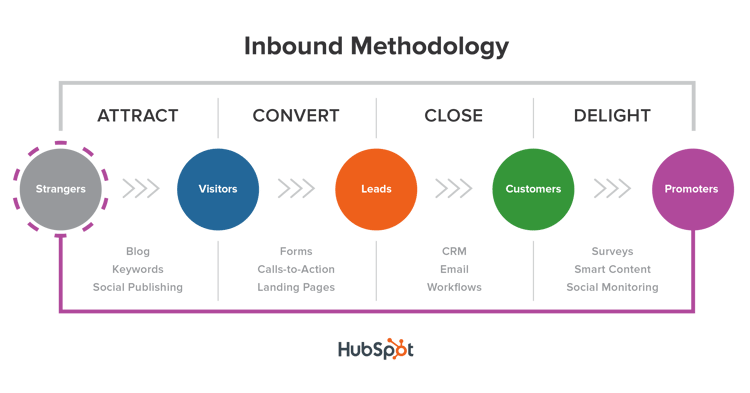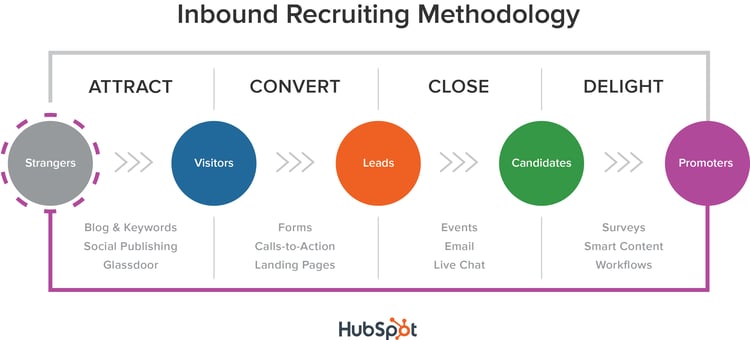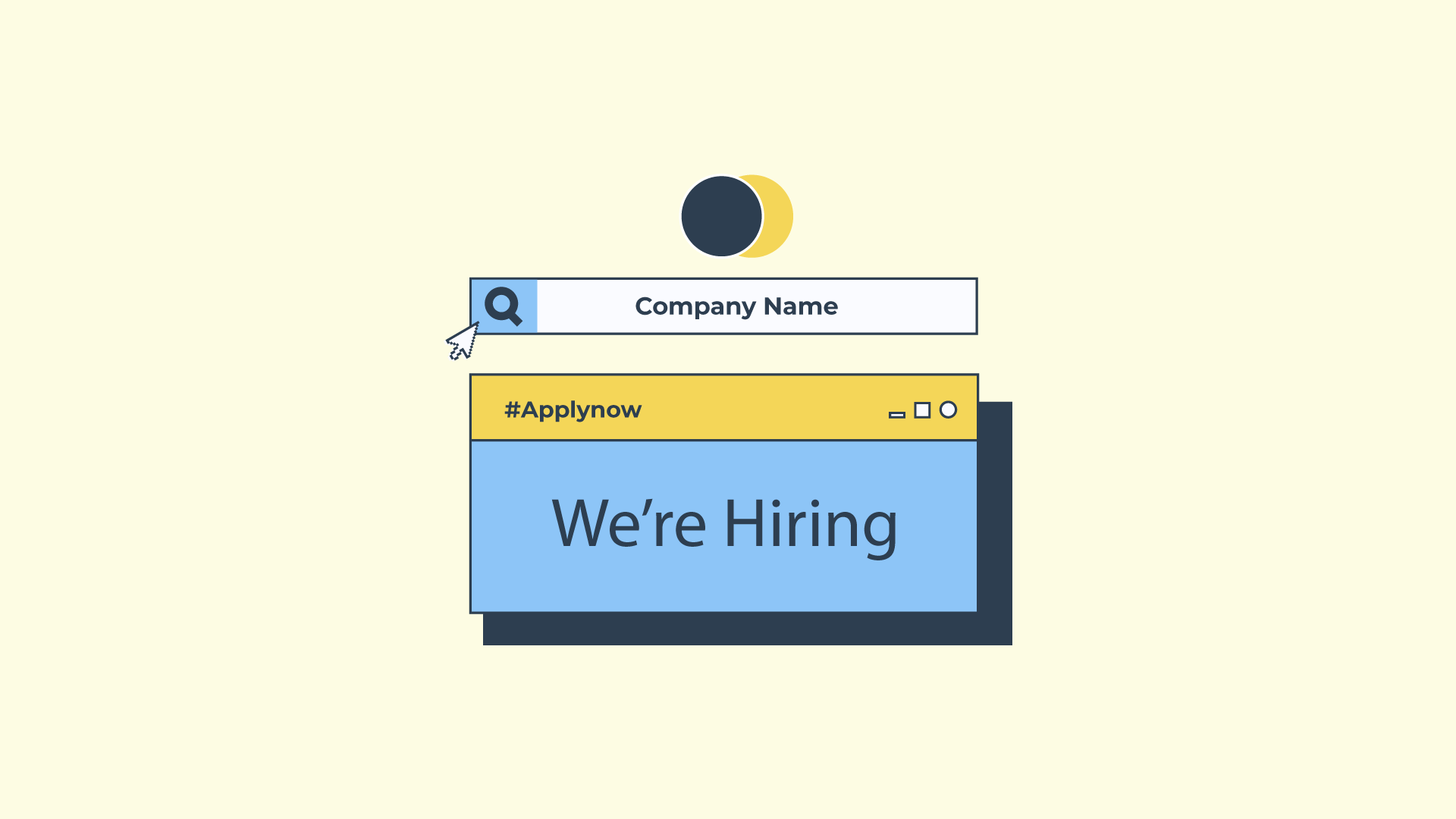How do you get new hires to join your team? How do you convince them to stay once they've joined? What are some ways to improve retention rates?
Recruitment has become a critical part of running a successful company. The cost of hiring employees can easily exceed $100,000 per year. And according to a recent study from CareerBuilder, nearly half (46%) of employers say their biggest challenge is retaining top talent.
Hiring great candidates isn't always easy. Companies should focus on improving their recruitment processes to attract and retain the best workers.
In this blog post, we'll introduce you to what is Inbound Recruiting and why it's important, the differences between Inbound and outbound recruitment, steps on how to do inbound recruitment, and how that role is evolving.
|
Inbound Recruiting |
What is Inbound Recruitment?
Inbound Recruiting is attracting, engaging, recruiting, and retaining talented people through effective marketing techniques. Inbound Recruitment is a strategy employed by human resource professionals, recruiters, and marketers.
The idea behind inbound recruiting is to attract qualified candidates who have already expressed an interest in working with you. This means they’ve done some research on what kind of role they want and where they see themselves professionally.
It's supported by certain sets of skills, practices, and technology that have become essential for companies to hire the best employees.
Inbound recruiting methods include attracting the attention of potential candidates by writing insightful blogs, using effective SEO, creating relevant social media postings, and other forms of content marketing. Recruiters often think of inbound recruiting as a combination of brand building and recruitment marketing that attracts ideal candidates who are well-suited for your organization's career opportunities.
Inbound Recruiting vs Outbound Recruiting
On the other hand, outbound marketing involves buying ads, creating an email list, and hoping for a lead. Inbound advertising focuses on creating content that attracts potential employees and helps them understand why they want to join your organization. By focusing on the needs of job candidates, you increase the chances of them becoming interested in your company, which leads to them being hired and retained in the long run.
Companies that invest heavily in an effective inbound recruiting strategy tend to hire exceptional people for their positions at a lower cost than companies that rely solely on traditional outbound hiring methods. An organization benefits when its bottom line is healthy and its employees are happy and productive, and positive brand awareness.
Inbound Marketing Meets Recruiting
Does the inbound concept sound familiar? HubSpot coined the word "inbound" back in 2006 to describe a new approach to attracting, engaging and delighting customers. In HubSpot's research, they found that people had tuned out traditional advertising and were turning instead to online searches for information.
Traditional approaches to advertising just didn't work anymore. So they developed an innovative method called inbound to bring attention to your business and get people interested in what you're offering.
Today, tens of thousands of companies worldwide use inbound marketing to attract new customers. That’s why the original inbound marketing is the blueprint for an Inbound recruitment strategy.

The graphic above shows four different phases of inbound marketing. Instead of attracting, engaging, and delighting customers, the goal in the recruiting world is to attract, engage, and delight your candidates.
Borrowing from the inbound methodology, below is an overview of the inbound recruitment methodology featuring the four stages candidates go through when looking for jobs, and the interactions they may have with your employer branding.

Consider this graphic: Consider your business' candidate experience at each stage. How do job seekers first find out about your company? You may have a career blog that attracts your audience, and social media content that makes people aware of your company. If someone visits your job site for the very first time, are there ways to get them engaged and interacting?
Signing up for a career blog or joining your company’s social media community are good ways to convert interest into action.
It's important to nurture existing business relations with leads who have expressed an interest in your company. Sending emails to your lead candidates with helpful content about your culture and your recruitment process, hosting recruiting events for them, or providing them with an option to speak to someone at your organization through live chat are all methods to provide value in the hiring process.
Finally, how can you convert candidates into promoters? Creating a remarkable interviewing and application experience, surveying candidates after they've been interviewed, and offering candidates who didn't get hired the chance to stay in touch are ways to create a culture where people recommend your company to their friends and family.
Why is Inbound Recruitment Effective?
Recruiters need to be able to think like digital marketing experts because they're responsible for finding candidates who match their company's needs. Like marketers use targeted content to capture and turn prospects into customers. Creative recruiters can use the same techniques to attract top candidates.
Inbound recruitment creates amazing candidate experiences through employer branding, which is defined by the way you are perceived from the perspectives of candidates and employees.
Your job applicants become familiar with your company by using their knowledge and experiences of your products and/or services. Employer branding has an impact on everything from how you communicate as a brand online to the content of your job listings to the salary, benefits, and perk packages you offer.
Employer branding is an important part of attracting and retaining top employees.
Through strong employer branding, inbound recruitment:
- Grows a larger group of accomplished and experienced applicants.
- Requires less upfront, personal effort than outbound recruiting. (which requires intense scouting and tireless communication that leads to fewer ideal candidates)
- Produces extensive awareness of your company, and your products/services by creating valuable, engaging, and informative online materials.
- It allows employers to closely target potential employees in a way that traditional recruiting methods cannot achieve.
- It provides a long-term benefit for attracting talented people. over an indefinite time frame.
- Even if you've captured someone's interest, that does not guarantee they will apply. It's essential to convert that interest into an application.
How to Develop an Inbound Recruitment Strategy
Before developing an Inbound recruitment marketing strategy, you must first align need to align your team with your employer brand. Employer branding is important for promoting your company and building awareness around it among potential employees.
Your employer branding includes the following elements:
- Employee value proposition
- Company mission and values statement
- People and Culture
Once you've developed your employer brand, you can then start working on creating a recruitment strategy that will help you attract and hire top candidates.
Here is how to develop an inbound recruitment strategy:
1. Set your team goals
You won't achieve success if you don't know exactly what you want from recruitment marketing. You must first decide what it is you expect to get out of it before trying to implement any specific campaigns. You need clear and measurable SMART goals.
For example, your company might be focusing on hiring new employees, increasing the number of hires for a particular department, or bringing on additional senior leaders. Make sure you outline your goals for inbound recruiting and then make sure you have clear plans to measure them.
2. Define roles and responsibilities
If you're looking to hire people who fit into specific roles, having clear job descriptions and transparent expectations helps both your teams and the people recruit. If everyone involved in recruiting has a clear understanding of the role’s responsibilities and requirements, it makes it easier for your teams to market those roles and positions and for potential employees.
It can also help simplify the application process for candidates who know they want to join your company and are aware of what opportunities are available. Inbound recruitment continues throughout the hiring stage, so keep it relevant by tying it to your company's vision for new hires.
3. Determine the channels you'll use
You may be targeting specific individuals for certain jobs, but when you're ready to advertise open positions, you'll want to identify the best ways to reach the widest audience.
For example, there exist platforms that allow recruitment teams to advertise jobs to diverse candidates. Others are specific to job type (e.g., developer or engineer), while others focus on demographic groups (e.g., women or minorities). Regardless of what type of diversity you're targeting, knowing where to find diverse talent can help your team quickly fill positions.
While many candidates are actively participating in online communities and networks these days, digital recruitment is not necessarily the only channel you should consider. In-person events and networking days can also be effective ways to find new talent.
4. Identify resources and capacity
Resources can be limited if your organization has 10 people on staff or 2 on your recruitment team. You must do more with less. That could mean starting slowly and building your way up to more frequent content creation and social media management.
You should consider asking your marketing team for help or insight into how they manage their task, budget, and capacity for marketing efforts. If you cannot handle things internally, outsourcing certain tasks might make the most sense for you.
The most important part is ensuring you can consistently work on your recruiting efforts. If you treat them like a one-time project, your team might spend time and resources without any real return.
5. Create calendars
Content is going to help you out when trying to recruit new employees. However, how, when, why, and where you work on your inbound recruiting efforts will largely dictate their success.
That's where calendars come into play. Content marketing managers create content calendars that include their content goals, the types of content they plan to produce, timelines for producing them, and where they'll publish them. You'll need to do the same for recruiting content.
It benefits both your team and long-term goals. Once you've got everything clearly defined and written down, it makes it easier for you to create repeatable processes that you can use now and into the future.
The Future of Inbound Recruitment
If you want to truly delight your audience wherever and whenever they are, your career portals and applications must be designed for mobile first.
By 2025, 75% of the workforce will be made up of millennials or Gen Z. This is the first generation of people who grew up using smartphones, so reaching them through mobile devices is the best strategy for connecting with them.
According to Glassdoor’s Job Seeker Survey, 89% of job seekers say they use their smartphones to research jobs, with 45% doing so at least once per day.
The application process needs to be as painless as possible - with easy applications to fill out through social media platforms like Facebook or LinkedIn. You want them to be able to complete an application, as you commute, and get a reminder while walking the dogs.
You may have noticed a heavy reliance on technology throughout these points. That’s because the inbound methodology relies heavily upon technology to automate much of the process. This allows you to spend far fewer hours on tedious tasks such as emailing, calling, and sending out paper applications. Your job can instead be spent communicating with your leads, building trust, and delivering an offer they simply cannot refuse.



